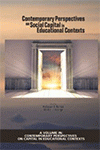
Contemporary Perspectives on Social Capital in Educational Contexts
Edited by:
RoSusan D. Bartee, University of Central Florida
Phillis George, University of Mississippi
A volume in the series: Contemporary Perspectives on Capital in Educational Contexts. Editor(s): RoSusan D. Bartee, University of Central Florida.
Published 2019
The currency of social capital serves as an important function given the capacity to generate external access (getting to) and internal accountability (getting through) for individuals and institutions alike. Pierre Bourdieu (1986) defines social capital as “the aggregate of the actual or potential resources which are linked to possession of a durable network of more or less institutionalized relationships of mutual acquaintance and recognition or in other words, to membership in a group” (p. 251). Social capital contains embedded resources as a tool for manifesting opportunities and options among individuals and groups. Inevitably, the aforementioned opportunities and options become reflective of the depth and breadth of access and accountability experienced by the individual and institution. As educational stakeholders, we must consistently challenge ourselves with the question, “How do K-12 schools and colleges and universities accomplish shared, egalitarian goals of achieving access and accountability?” Such goals become fundamental toward ensuring students matriculating through K-12 and higher education, irrespective of background, are provided the caliber of education and schooling experience to prepare them for economic mobility and social stability.
To that end, the volume, Contemporary Perspectives on Social Capital in Educational Contexts (2019), as part of the book series, Contemporary Perspectives on Capital in Educational Contexts, offers a unique opportunity to explore social capital as a currency conduit for creating external access and internal accountability for K-12 and higher education. The commonalities of social capital emerging within the 12 chapters of the volume include the following: 1) Social Capital as Human Connectedness; 2) Social Capital as Strategic Advocacy; 3) Social Capital as Intentional Engagement; and 4) Social Capital as Culturally-Responsive Leadership. Thus, it becomes important for institutions of education (i.e. secondary, postsecondary, continuing) and individuals to assume efforts with intentionality and deliberateness to promote access and accountability.
CONTENTS
FOREWORD-External Access and Internal Accountability: The Currency Conduits for Maximizing Social Capital in Public Schools and Higher Education, RoSusan D. Bartee and Phillis L. George. PART I: ACCOUNTABILITY STRUCTURES. PART I.A: LEADERSHIP CAPACITY. The Role of School Leaders Managing Social Capital Within Urban and Rural School Settings, John Crutchfield, Sarah Bailey, and Jandel Crutchfield. Social Capital and School Reform: The Role of School Leaders in Fostering Relationships Amongst Stakeholders, Denver J. Fowler. Building Social Capital for Parents and Families Through School Leadership, Roberto Trigosso, Phyllis F. Reggio, and Carlos R. McCray. PART I.B: RESOURCES, MEASUREMENT, AND MISSION STATEMENTS. Nyeisha’s Mother: An Ethnographic Examination of Urban Schooling and Adopting a Resource Orientation Toward Social Capital, Nicole Mittenfelner Carl. The Past, Present, and Future of Social Capital Measurement among Transition-Age Youth, Sarah Ryan and Lisa Romero. Diversity Mission Statement Inclusion as Social Capital: How the Language of Appeasement Fails Egalitarian Goals in Postsecondary Institutions, Zachary W. Taylor, Alden C. Jones, and Catherine E. Hartman. PART II: ACCESS STRATEGIES. PART II.A: INSTITUTIONALIZED ACTIONS AND AGENTS. Still Chasing the Dream: The Possibilities and Limitations of Social Capital in Dismantling Racialized Tracks, Richard Lofton, Jr. Embracing the Fullness of Postsecondary Planning: Utilizing Social Capital to Serve Students at the Nexus of Navigational Capital and Care, Raquel Farmer-Hinton and Nicole E. Holland. Nós Por Nós (Us for Us): Black Brazilian University Students and Social Capital, Jeana E. Morrison. PART II.B: PARTNERSHIPS AND EDUCATIONAL ATTAINMENT. Social Capital Resources in Schools: Explaining Effective School Community, Heather E. Price. Social Capital and Educational Expectations: Exploring Adolescents’ Capabilities to Aspire for Postsecondary Education, Chrysa Pui Chi Keung and Esther Sui Chu Ho. Social Capital in the Rural United States and Its Impact on Educational, Ty McNamee. AFTERWORD- Redefining Social Capital with an Eye Toward Critical Proactiveness, Phillis L. George.
-
Paperback9781641136389
Web price: $45.04 (Reg. 52.99)
-
Hardcover9781641136396
Web price: $80.74 (Reg. 94.99)
- eBook9781641136402

- EDU001000 - EDUCATION: ADMINISTRATION: General
- EDU037000 - EDUCATION: Research
- EDU054000 - EDUCATION: Urban
-
 (Re)Envisioning Social Studies Education Research
Current Epistemological and Methodological Expansions, Deconstructions, and Creations
(Re)Envisioning Social Studies Education Research
Current Epistemological and Methodological Expansions, Deconstructions, and Creations
-
 Contemporary Perspective on Capital in Educational Contexts
Contemporary Perspective on Capital in Educational Contexts
-
 Distance Learning
Volume 20 #3
Distance Learning
Volume 20 #3
-
 Distance Learning
Volume 20 #4
Distance Learning
Volume 20 #4
-
 Diversity as Strategic Opportunity
Exploring New Paths to Good Administration
Diversity as Strategic Opportunity
Exploring New Paths to Good Administration
-
 Qualitative Research With Diverse and Underserved Communities
Qualitative Research With Diverse and Underserved Communities
-
 Quarterly Review of Distance Education
Volume 24 #1
Quarterly Review of Distance Education
Volume 24 #1

